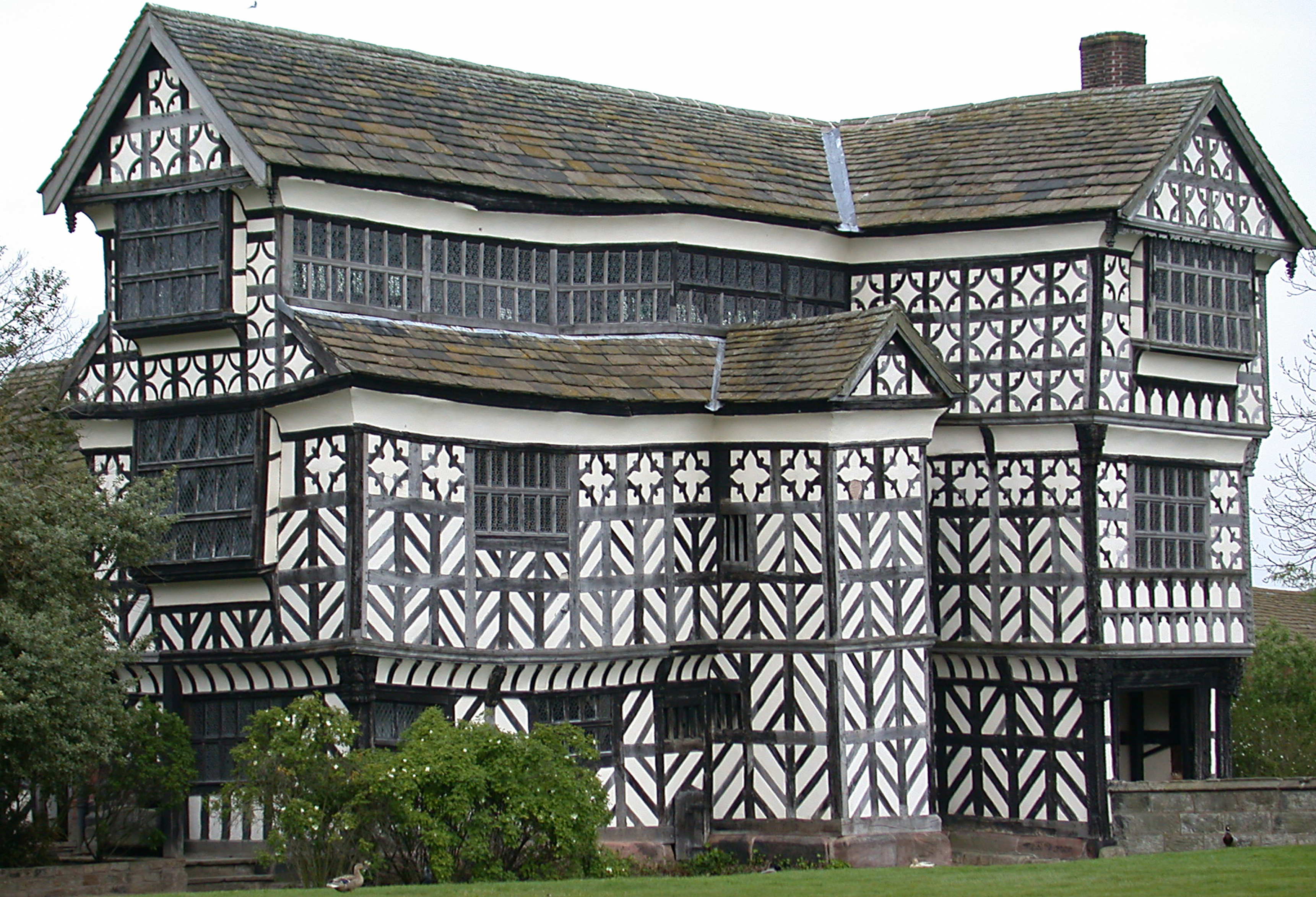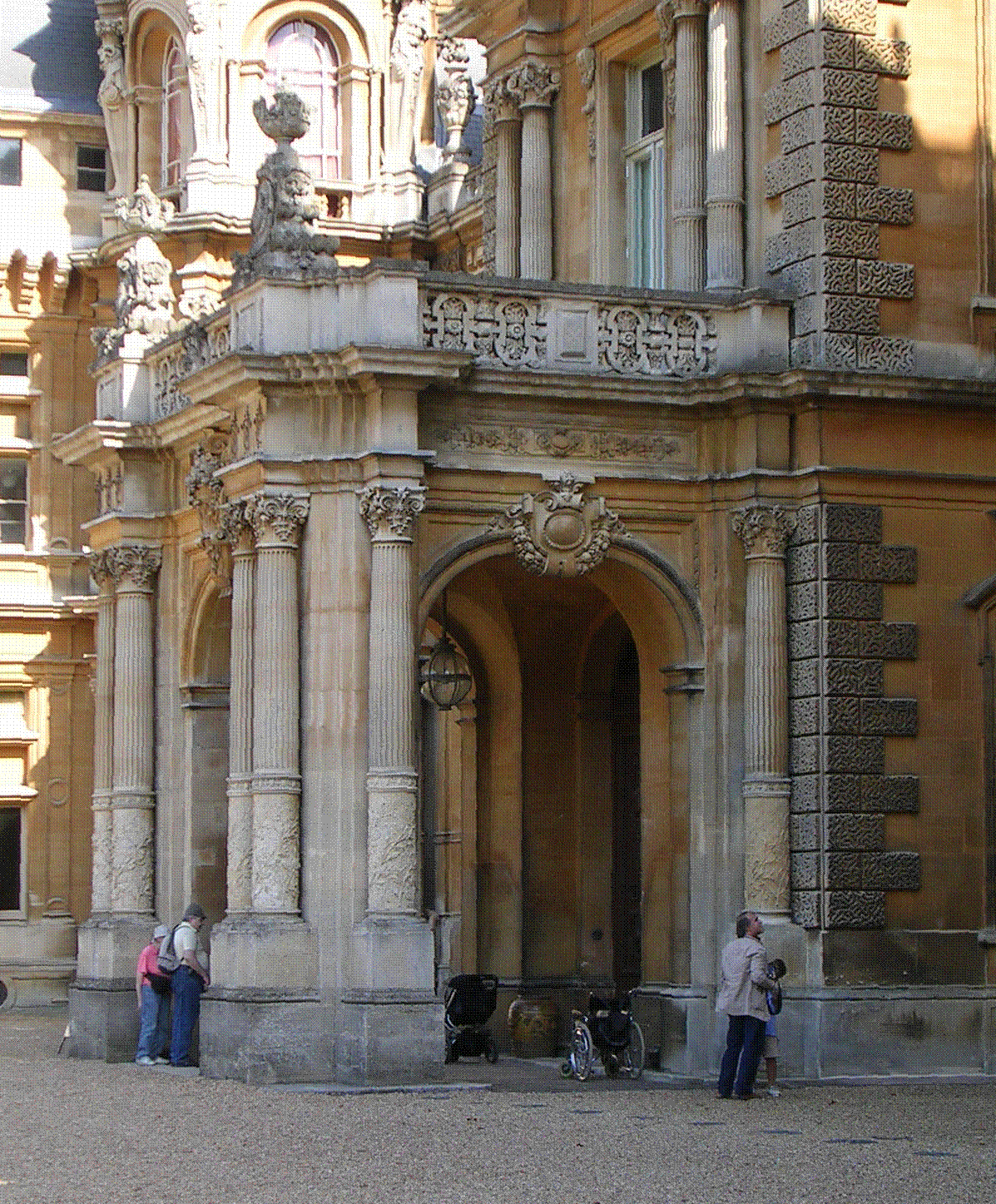|
Great Moreton Hall
Great Moreton Hall is a former country house in Moreton cum Alcumlow near Congleton, in Cheshire, England, less than a mile (1.6 km) from its better-known near namesake Little Moreton Hall. Designed by Edward Blore, it was built in 1841 by Manchester businessman George Holland Ackers, to replace a large timber-framed building that had been the home of the Bellot family since 1602. Great Moreton Hall is built in two storeys, interspersed with three and four-storey towers. The service wing to the left of and adjoining the main part of the building is slightly lower than the rest of the structure. The main entrance is via a broad flight of steps from a porte-cochère, leading to the entrance lobby and a large central hall. A triple arcade at one end of the hall leads to the main staircase, opposite a hooded fireplace decorated with the arms of the Ackers family. The Library, Drawing Room, Billiard Room, Saloon, and the Great Hall are arranged symmetrically around the central ... [...More Info...] [...Related Items...] OR: [Wikipedia] [Google] [Baidu] |
Moreton Cum Alcumlow
Moreton cum Alcumlow is a small civil parish in the unitary authority of Cheshire East and the ceremonial county of Cheshire, England. In the census of 2001 it was recorded as having a population of 150. The civil parish holds a parish council meeting under a grouping scheme with the adjacent civil parish of Newbold Astbury, and so it is consequently called Newbold Astbury-cum-Moreton Parish Council. Borough of Congleton Official Website. Retrieval Date: February 11, 2008. Within the civil parish is the small village of Ackers Crossing, and Alcumlow Hall and ( |
Cheshire
Cheshire ( ) is a ceremonial and historic county in North West England, bordered by Wales to the west, Merseyside and Greater Manchester to the north, Derbyshire to the east, and Staffordshire and Shropshire to the south. Cheshire's county town is the cathedral city of Chester, while its largest town by population is Warrington. Other towns in the county include Alsager, Congleton, Crewe, Ellesmere Port, Frodsham, Knutsford, Macclesfield, Middlewich, Nantwich, Neston, Northwich, Poynton, Runcorn, Sandbach, Widnes, Wilmslow, and Winsford. Cheshire is split into the administrative districts of Cheshire West and Chester, Cheshire East, Halton, and Warrington. The county covers and has a population of around 1.1 million as of 2021. It is mostly rural, with a number of towns and villages supporting the agricultural and chemical industries; it is primarily known for producing chemicals, Cheshire cheese, salt, and silk. It has also had an impact on popular culture, producin ... [...More Info...] [...Related Items...] OR: [Wikipedia] [Google] [Baidu] |
Edward Blore
Edward Blore (13 September 1787 – 4 September 1879) was a 19th-century English landscape and architectural artist, architect and antiquary. Early career He was born in Derby, the son of the antiquarian writer Thomas Blore. Blore's background was in antiquarian draughtsmanship rather than architecture, in which he had no formal training. Nevertheless, he designed Vorontsov Palace (Alupka), a large palace for Count Vorontsov in Alupka, Crimea, and important ecclesiastical furnishings designed by him included organ cases for Winchester Cathedral and Peterborough Cathedral (the Peterborough case since removed) and the choir stalls in Westminster Abbey. Charles Locke Eastlake, writing in 1872, believed that he had been apprenticed to an engraver,Eastlake 1873, p.138 but other sources dispute this. He illustrated his father's ''History of Rutland'' (1811), and over the next few years he made the drawings of York Minster, York and Peterborough and measured drawings of Wincheste ... [...More Info...] [...Related Items...] OR: [Wikipedia] [Google] [Baidu] |
English Country House
An English country house is a large house or mansion in the English countryside. Such houses were often owned by individuals who also owned a town house. This allowed them to spend time in the country and in the city—hence, for these people, the term distinguished between town and country. However, the term also encompasses houses that were, and often still are, the full-time residence for the landed gentry who ruled rural Britain until the Reform Act 1832. Frequently, the formal business of the counties was transacted in these country houses, having functional antecedents in manor houses. With large numbers of indoor and outdoor staff, country houses were important as places of employment for many rural communities. In turn, until the agricultural depressions of the 1870s, the estates, of which country houses were the hub, provided their owners with incomes. However, the late 19th and early 20th centuries were the swansong of the traditional English country house lifest ... [...More Info...] [...Related Items...] OR: [Wikipedia] [Google] [Baidu] |
Congleton
Congleton is a town and civil parish in the unitary authority of Cheshire East in Cheshire, England. The town is by the River Dane, south of Manchester and north of Stoke on Trent. At the 2011 Census, it had a population of 26,482. Toponymy The town's name is of unknown origin. The first recorded reference to it was in 1282, when it was spelt ''Congelton''. The element ''Congle'' might relate to the old Norse ''kang'' meaning a bend, followed by the Old English element ''tun'' meaning settlement. History The first settlements in the Congleton area were Neolithic. Stone Age and Bronze Age artefacts have been found in the town. Congleton was once thought to have been a Roman settlement, although there is no archaeological or documentary evidence to support this. Congleton became a market town after Vikings destroyed nearby Davenport. Godwin, Earl of Wessex held the town in the Saxon period. The town is mentioned in the Domesday Book, where it is listed as ''Cogeltone: ... [...More Info...] [...Related Items...] OR: [Wikipedia] [Google] [Baidu] |
Little Moreton Hall
Little Moreton Hall, also known as Old Moreton Hall, is a moated half-timbered manor house southwest of Congleton in Cheshire, England. The earliest parts of the house were built for the prosperous Cheshire landowner William Moreton in about 1504–08, and the remainder was constructed in stages by successive generations of the family until about 1610. The building is highly irregular, with three asymmetrical ranges forming a small, rectangular cobbled courtyard. A National Trust guidebook describes Little Moreton Hall as being "lifted straight from a fairy story, a gingerbread house". The house's top-heavy appearance, "like a stranded Noah's Ark", is due to the Long Gallery that runs the length of the south range's upper floor. The house remained in the possession of the Moreton family for almost 450 years, until ownership was transferred to the National Trust in 1938. Little Moreton Hall and its sandstone bridge across the moat are recorded in the National Heritage List for ... [...More Info...] [...Related Items...] OR: [Wikipedia] [Google] [Baidu] |
Manchester
Manchester () is a city in Greater Manchester, England. It had a population of 552,000 in 2021. It is bordered by the Cheshire Plain to the south, the Pennines to the north and east, and the neighbouring city of Salford to the west. The two cities and the surrounding towns form one of the United Kingdom's most populous conurbations, the Greater Manchester Built-up Area, which has a population of 2.87 million. The history of Manchester began with the civilian settlement associated with the Roman fort ('' castra'') of ''Mamucium'' or ''Mancunium'', established in about AD 79 on a sandstone bluff near the confluence of the rivers Medlock and Irwell. Historically part of Lancashire, areas of Cheshire south of the River Mersey were incorporated into Manchester in the 20th century, including Wythenshawe in 1931. Throughout the Middle Ages Manchester remained a manorial township, but began to expand "at an astonishing rate" around the turn of the 19th century. Manchest ... [...More Info...] [...Related Items...] OR: [Wikipedia] [Google] [Baidu] |
Timber-framed
Timber framing (german: Holzfachwerk) and "post-and-beam" construction are traditional methods of building with heavy timbers, creating structures using squared-off and carefully fitted and joined timbers with joints secured by large wooden pegs. If the structural frame of load-bearing timber is left exposed on the exterior of the building it may be referred to as half-timbered, and in many cases the infill between timbers will be used for decorative effect. The country most known for this kind of architecture is Germany, where timber-framed houses are spread all over the country. The method comes from working directly from logs and trees rather than pre-cut dimensional lumber. Hewing this with broadaxes, adzes, and draw knives and using hand-powered braces and augers (brace and bit) and other woodworking tools, artisans or framers could gradually assemble a building. Since this building method has been used for thousands of years in many parts of the world, many styles ... [...More Info...] [...Related Items...] OR: [Wikipedia] [Google] [Baidu] |
Porte-cochère
A porte-cochère (; , late 17th century, literally 'coach gateway'; plural: porte-cochères, portes-cochères) is a doorway to a building or courtyard, "often very grand," through which vehicles can enter from the street or a covered porch-like structure at a main or secondary entrance to a building through which originally a horse and carriage and today a motor vehicle can pass to provide arriving and departing occupants protection from the elements. Portes-cochères are still found on such structures as major public buildings and hotels, providing covered access for visitors and guests arriving by motorized transport. A porte-cochère, a structure for vehicle passage, is to be distinguished from a portico, a columned porch or entry for human, rather than vehicular, traffic. History The porte-cochère was a feature of many late 18th- and 19th-century mansions and public buildings. A well-known example is at Buckingham Palace in London. A portico at the White House in Wa ... [...More Info...] [...Related Items...] OR: [Wikipedia] [Google] [Baidu] |
Listed Building
In the United Kingdom, a listed building or listed structure is one that has been placed on one of the four statutory lists maintained by Historic England in England, Historic Environment Scotland in Scotland, in Wales, and the Northern Ireland Environment Agency in Northern Ireland. The term has also been used in the Republic of Ireland, where buildings are protected under the Planning and Development Act 2000. The statutory term in Ireland is " protected structure". A listed building may not be demolished, extended, or altered without special permission from the local planning authority, which typically consults the relevant central government agency, particularly for significant alterations to the more notable listed buildings. In England and Wales, a national amenity society must be notified of any work to a listed building which involves any element of demolition. Exemption from secular listed building control is provided for some buildings in current use for worship, ... [...More Info...] [...Related Items...] OR: [Wikipedia] [Google] [Baidu] |
Grade II* Listed Buildings In Cheshire East
There are over 20,000 Grade II* listed buildings in England. This page is a list of these buildings in the unitary authority of Cheshire East. Listed buildings Notes See also *Grade I listed buildings in Cheshire East *Grade II* listed buildings in Cheshire ** Grade II* listed buildings in Cheshire West and Chester There are over 20,000 Grade II* listed buildings in England. This page is a list of these buildings in the unitary authority of Cheshire West and Chester. List ... ** Grade II* listed buildings in Cheshire East ** Grade II* listed buildings in Warrington ** Grade II* listed buildings in Halton (borough) References Notes External links {{DEFAULTSORT:Grade II listed buildings in Cheshire ... [...More Info...] [...Related Items...] OR: [Wikipedia] [Google] [Baidu] |


.jpg)
_in_1902.png)



